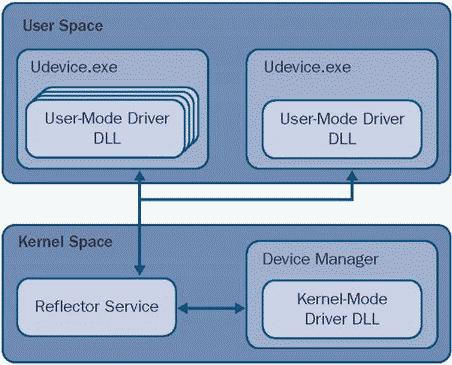Книга: Microsoft Windows Embedded CE 6.0 Exam Preparation Kit
User-Mode Drivers and the Reflector Service
User-Mode Drivers and the Reflector Service
In order to communicate with the underlying hardware and perform useful tasks, user-mode drivers must be able to access system memory and privileged APIs unavailable to standard user-mode processes. To facilitate this, Windows Embedded CE 6.0 features a Reflector service, which runs in kernel mode, performs buffer marshaling, and calls privileged memory management APIs on behalf of the user- mode drivers. The Reflector service is transparent so that user-mode drivers can work almost the same way as kernel-mode drivers without modifications. An exception to this rule is a driver that uses kernel APIs that are not available in user mode. It is not possible to run these types of kernel-mode drivers in user mode.
When an application calls ActivateDeviceEx, Device Manager loads the driver either directly in kernel space or passes the request to the Reflector service, which in turn starts a user mode driver host process (Udevice.exe) through a CreateProcess call. The Flags registry entry in the driver's registry key determines whether a driver should run in user mode (DEVFLAGS_LOAD_AS_USERPROC flag). Having started the required instance of Udevice.exe and user-mode driver, the Reflector service forwards the XXX_Init call from Device Manager to the user-mode driver and returns the return code from the user-mode driver back to Device Manager, as indicated in Figure 6-5. The same proxy principle also applies to all other stream functions.

Figure 6-5 User-mode drivers, kernel-mode drivers, and the Reflector service
- Разработка приложений баз данных InterBase на Borland Delphi
- 4.4.4 The Dispatcher
- Open Source Insight and Discussion
- Introduction to Microprocessors and Microcontrollers
- About the author
- Chapter 6. Traversing of tables and chains
- Chapter 7. The state machine
- Chapter 8. Saving and restoring large rule-sets
- Chapter 11. Iptables targets and jumps
- Chapter 5 Installing and Configuring VirtualCenter 2.0
- Chapter 15. Graphical User Interfaces for Iptables
- Chapter 16. Commercial products based on Linux, iptables and netfilter




